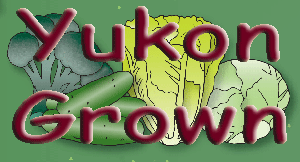“Veggies” Under the Aurora …& harvested too!
The purpose of this unit is to deliver the message that we can grow and harvest Yukon foods.
The unit considers only the plant aspect of Yukon grown, with the hope of encouraging healthy living practises that “plant the seed” in our classrooms, and “take root” in our communities. Students will learn to experience Yukon foods and hopefully “grow” this experience through life.
The Yukon Agriculture Branch in partnership with industry defines Yukon grown in two aspects: i. crop production, and ii. livestock production. The crop production definition is as follows:
GROWING IN THE YUKON Local foods do matter and lots of goodness is connected to local foods, such as:
- Health and nutrition
- Cultural practices,
- Political thinking, and
- …the fine art of home grown and home cooking!
ENCOURAGEMENTS: If you do grow and harvest your own food, you will learn that:
- root crops grow very well,
- growing conditions allow for minimal plant disease,
- Yukon is perceived as a clean place to grow foods, and
- Yukoners value locally grown and harvested foods.
CHALLENGES: All good things have challenges….growing in the Yukon does have challenges, but nothing that is insurmountable. Forward thinking folk have worked with the challenges and provide us with in sight into practises that make growing in the Yukon a backyard experience. These challenges are:
- Climatic limitations of a cold and dry environment,
- Generally the soils lack organic matter (especially in the Whitehorse area),
- Limited community infrastructure to support locally grown, and
- Limited available skilled and unskilled labour
(taken from: Multi-year Development Plan for Yukon Agriculture (2008 – 2012))
CHECK THIS OUT: Farm to School Salad Bar at www.phabc.org/farmtoschool. It is a healthy eating initiative supported by Public Health Assn. OF B.C. There might be some ideas that could strengthen students connection to soil.
WHAT CAN WE GROW IN A YUKON GARDEN?
Recommended Resources:
- Celebrate Yukon Food: seasonal recipes (2006): Fireweed Community Market Society
- Yukon Farm Products & Services (2008)
- Profiles of Northern Agriculturists (2000)
- Yukon Gardener’s Manual (2005)
- Yukon Grown poster (2009)
“FARM OUT” YUKON TRIVIA!
- The Pelly Farm (1901 – 1954), which is really the Pelly River Ranch (1954 to present) is one of the oldest farms in the Yukon. For more than 50 years the Bradley family has practised sustainable farming – feeding to their livestock only what they grow. The location of Pelly River Ranch was selected because of its proximity to the Dawson Trail. Pelly Farm was an important resting stop for weary travellers and provided winter boarding for horses required to pull coaches along the Dawson Trail.
- Mile 1019 Experimental Farm, Alaska Highway near Haines Junction was operated by the Government of Canada (1945 -1968), the land was eventually leased to the Tait family for market gardening and potatoe production. The Mile 1019 Experimental Farm was purposely situated in one of the coldest Yukon valleys (approximately 21 frost free days!). The rationale of this site was that anything grown in this location would produce more abundantly in a warmer location. Conditions at Mile 1019 could determine which plants and livestock could adapt to northern latitudes.
- Some of the best growing conditions in the Yukon are in the Mayo area and Klondike Valley. The winters are severe, but the summers are warm and long ( approximately 100 frost free days!). Yields of locally grown foods are comparable to that of southern Canada. Farming and gardening was introduced into both areas with the influx of gold seekers. In the vicinity of Dawson City many, many river valley acres were put into production.
- Today most of the farms are in the Whitehorse area (approximately 70 frost free days). With a bit of patience and innovation things can grow and do surprisingly well!
- Hardy fruit trees, such as Norland apple, Siberian pear, Evans cherries can survive Yukon winters, if extensively protected with layers of mulch. Though slower in growing to production, trees will eventually yield fruits.
- When Yukoners think of potatoes, often Yukon Gold will come to mind. Yukon Gold potatoes are genetically the first Canadian created potatoe, but from the School of Agriculture at the University of Guelph. This potatoe was first marketed in Ontario before its import to the Yukon. Yukon Gold was named for its yellow colour.
- Grains can be grown in the Yukon. Barley will grow in the Whitehorse area. Wheat and Oats do not do as well in the Whitehorse area, but will do better in the Mayo and Dawson area.
- Yukon Grown is defined by the Agriculture industry as, “plants…that originated from a Yukon source and/or imported from an outside source and grown in the Yukon for no less than 51% of its lifecycle, and/or a plant that continues to grow …in the Yukon for no less than one complete year.”
For more farm out trivia:
Whitehorse Food Bank
Potluck Community Co-op
Growers of Organic Food Yukon
Fireweed Community Market Society
Yukon Agriculture Association Newsletter
InFARMation: Yukon Agriculture Branch Quarterly Bulletin
Download a printable version of this information (PDF) |
